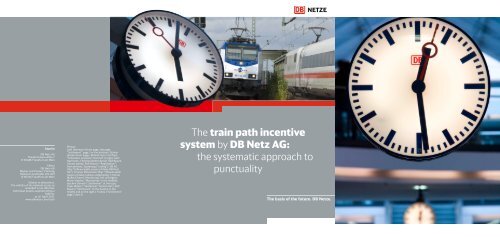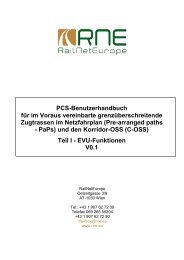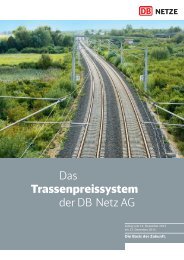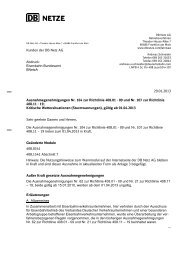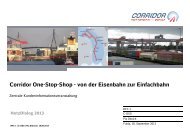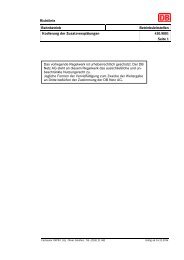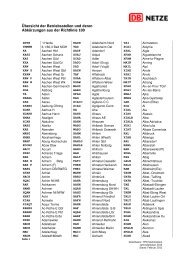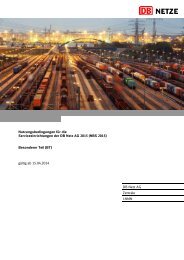PDF Download - DB Netz AG
PDF Download - DB Netz AG
PDF Download - DB Netz AG
Create successful ePaper yourself
Turn your PDF publications into a flip-book with our unique Google optimized e-Paper software.
Imprint<br />
<strong>DB</strong> <strong>Netz</strong> <strong>AG</strong><br />
Theodor-Heuss-Allee 7<br />
D-60486 Frankfurt am Main<br />
Editor<br />
<strong>DB</strong> <strong>Netz</strong> <strong>AG</strong><br />
Market and Product Planning<br />
Mainzer Landstraße 201-203<br />
D-60326 Frankfurt am Main<br />
Subject to alterations.<br />
The validity of the network access as<br />
amended is not affected.<br />
Individual details supplied without<br />
liability.<br />
as of: April 2011<br />
www.dbnetze.com/track<br />
Photos:<br />
Axel Hartmann (front page, last page,<br />
“Settlement” page 3 at the bottom); Günter<br />
Jazbek (front page), Roland Horn (1st flap);<br />
“Schematic overview” from left to right: Axel<br />
Hartmann, Christian Bedeschinski, Ralf Braum,<br />
Günter Jazbek; Ralf Braum (“Registration”:<br />
both photos); Saarbourg (“coding”); <strong>DB</strong> <strong>AG</strong><br />
(flap “Influenceable causes of delay <strong>DB</strong> <strong>Netz</strong><br />
<strong>AG</strong>”); Thomas Rittelmann (flap “Influenceable<br />
causes of delay railway undertaking”); Heiner<br />
Müller-Elsner (“Monitoring” left and right);<br />
Mario Vedder (“Monitoring” in the middle);<br />
Joachim Donath (“Settlement” at the top);<br />
Claus Weber (“Settlement” bottom left); Ralf<br />
Braum (“Settlement” at the bottom in the<br />
middle and on the right); Fotolia (“Settlement”<br />
page 2 and 3)<br />
The train path incentive<br />
system by <strong>DB</strong> <strong>Netz</strong> <strong>AG</strong>:<br />
the systematic approach to<br />
punctuality<br />
The basis of the future. <strong>DB</strong> <strong>Netz</strong>e.
Schematic overview<br />
Planned<br />
time<br />
Additional delay<br />
From departure to settlement<br />
The following diagram gives a clearly<br />
structured impression and explanation<br />
of the train path incentive system.<br />
Berlin<br />
Departure: 10:31 hrs<br />
Braunschweig<br />
11:58 hrs<br />
15 minutes delay<br />
Door closing device<br />
defective<br />
Code 62: RU<br />
Passenger coach<br />
The example is based on a fictitious<br />
passenger train from Berlin to Frankfurt.<br />
Kassel-Wilhelmshöhe<br />
13:16 hrs<br />
10 minutes delay<br />
Line blocked<br />
Code 31: <strong>DB</strong> <strong>Netz</strong> <strong>AG</strong><br />
Engineering work<br />
Three delays are ascertained for this<br />
route. Each delay is given its own code,<br />
with a clear definition of the cause and<br />
corresponding responsibility.<br />
Fulda<br />
13:47 hrs<br />
8 minutes delay<br />
Journey to command<br />
Code 25: <strong>DB</strong> <strong>Netz</strong> <strong>AG</strong><br />
Command and control<br />
systems<br />
At the end of the year, the coded delay<br />
minutes are settled between the railway<br />
undertaking and <strong>DB</strong> <strong>Netz</strong> <strong>AG</strong>.<br />
Frankfurt am Main<br />
Arrival: 14:44 hrs<br />
Delay!<br />
Actual arrival:<br />
15:17 hrs<br />
Hourly record<br />
Train number 277<br />
Code 62 RU: 15 minutes<br />
Code 31 <strong>DB</strong> <strong>Netz</strong> <strong>AG</strong>: 10 minutes<br />
Code 25 <strong>DB</strong> <strong>Netz</strong> <strong>AG</strong>: 8 minutes<br />
Settlement<br />
The delays generated by the RU<br />
and <strong>DB</strong> <strong>Netz</strong> <strong>AG</strong> are then settled<br />
on the basis of a settlement model.<br />
One delay minute corresponds to<br />
10 Ct.<br />
How <strong>DB</strong> <strong>Netz</strong> <strong>AG</strong> makes punctuality calculable<br />
<strong>DB</strong> <strong>Netz</strong> <strong>AG</strong>‘s ultimate aim is to warrant<br />
maximum punctuality for all its<br />
train paths. Nevertheless, certain<br />
imponderables and special situations<br />
can mean that it is not always possible<br />
to achieve this aim right down to<br />
the last minute. The train path incentive<br />
system by <strong>DB</strong> <strong>Netz</strong> <strong>AG</strong> takes a<br />
comprehensive, precisely elaborated<br />
systematic approach with transparent,<br />
comprehensible ascertainment and<br />
allocation of causes for possible hindrances.<br />
The train path incentive system has<br />
been developed to bring about a constant,<br />
consistent improvement in the<br />
quality of rail transport and acts as future-oriented<br />
motivation for satisfying<br />
all railway customers and railway undertakings<br />
in the best possible manner.<br />
Example:<br />
Punctuality degree of 80%<br />
The punctuality for all trains of the<br />
railway undertakings is calculated on<br />
a daily basis. To this end, en route<br />
punctuality is calculated for passenger<br />
trains. Passenger trains are still<br />
deemed punctual with delays of up to<br />
5:59 minutes.<br />
The punctuality of freight trains is calculated<br />
according to arrival at the terminus.<br />
Freight trains are still deemed<br />
punctual with delays of up to 30:59<br />
minutes.<br />
The degree of punctuality then results<br />
from the ratio of punctual trains to the<br />
total number of trains.<br />
80 punctual trains<br />
20<br />
delayed<br />
trains
Registration Coding<br />
Registration: 20% selected and announced early on<br />
For data recording, 20% of the train<br />
paths allocated in the working timetable<br />
are viewed, which you select<br />
according to your own criteria and<br />
send to us. These routes have to be<br />
Please note:<br />
Consideration is not given to the DC<br />
S-Bahn networks in Hamburg and Berlin,<br />
ad hoc traffic and journeys that<br />
need a special form of timetable (e.g.<br />
train control operation) because of the<br />
registered rolling stock, track conditions<br />
of other parameters.<br />
registered about two months before<br />
the working timetable begins. The<br />
routes are then viewed and measured<br />
throughout the whole year according<br />
to our parameters.<br />
Coding: Precise detection and allocation of the causes<br />
Coding gives <strong>DB</strong> <strong>Netz</strong> <strong>AG</strong> an instrument<br />
for precise allocation of delay<br />
causes.<br />
A coding key stipulates the two prime<br />
aspects:<br />
1. the cause of the delay, such as signal<br />
faults or vehicle faults, and<br />
2. the entity responsible for the delay,<br />
such as the railway undertaking or<br />
<strong>DB</strong> <strong>Netz</strong> <strong>AG</strong>.<br />
Most delay causes can be clearly allocated<br />
and are the responsibility either<br />
of <strong>DB</strong> <strong>Netz</strong> <strong>AG</strong> or of the railway undertaking.<br />
A corresponding catalogue of delay<br />
causes has been drawn up to facilitate<br />
allocation. (see example on the righthand<br />
flap).<br />
Coding is based on the coding list and<br />
Code of Practice 420.9001 with the<br />
explanations.<br />
The coding list can be viewed on the<br />
internet as Annex 7 to the Network<br />
Statement (SNB): www.dbnetze.com/<br />
networkstatement<br />
Code Delay cause<br />
10<br />
Timetable design<br />
(Sales)<br />
12 Scheduling faults<br />
13 Preparation (Operations)<br />
18 <strong>DB</strong> <strong>Netz</strong> operational staff<br />
19 <strong>DB</strong> <strong>Netz</strong> other operational issues<br />
21 Telecommunications systems<br />
22 Structures<br />
23 Track<br />
24 Level crossing safety systems<br />
25 Command and control systems<br />
28 <strong>DB</strong> <strong>Netz</strong> technical staff<br />
29 <strong>DB</strong> <strong>Netz</strong> other technical issues<br />
30<br />
Influenceable causes<br />
<strong>DB</strong> <strong>Netz</strong> <strong>AG</strong><br />
Temporary speed restriction<br />
for repairs<br />
31 Engineering work<br />
32 Irregularities in engineering works
Influenceable causes of delay<br />
RU<br />
Code Delay cause<br />
50 Stopping time exceeded<br />
51 RU application<br />
52 Loading work<br />
53 Irregularities with the load<br />
57 No report from RU<br />
58 RU�s traffic staff<br />
60 Block/deployment planning<br />
62 Passenger coach<br />
63 Wagon<br />
64 Traction unit<br />
68 RU technical staff<br />
Monitoring<br />
Delay monitoring: transparent and<br />
comprehensible<br />
The train path incentive system gives<br />
great significance to the maximum<br />
possible transparency, with corresponding<br />
records kept to ensure that<br />
the railway undertakings are always<br />
supplied with the latest information.<br />
This ensures that you have an overview<br />
at all times of all trains that<br />
have been registered in the incentive<br />
system, in terms of delay, cause and<br />
responsibility.<br />
Explanations about the records can be<br />
found on the internet:<br />
www.dbnetze.com/incentivesystem<br />
Correcting the delay causes: flexible and fair<br />
The train path incentive system offers<br />
the railway undertakings a fair, flexible<br />
correction procedure that works<br />
quickly without any undue complications.<br />
Correction requests always have<br />
to be implemented in the framework<br />
of the hourly and daily records. When<br />
accepted, they are then included in the<br />
weekly records. Detailed reasons are<br />
provided if the corrections are not ac-<br />
cepted. (The following diagram shows<br />
exactly how the correction procedures<br />
work.)<br />
The processes are stipulated in Code<br />
of Practice 420.9001. This can be<br />
consulted as Annex 7 in the Network<br />
Statement: www.dbnetze.com/<br />
networkstatement<br />
� � � � � � � �<br />
Delay!<br />
Validation<br />
In the validation phase,<br />
additional findings regarding<br />
the disruption<br />
can be asserted by <strong>DB</strong><br />
<strong>Netz</strong> <strong>AG</strong> and the railway<br />
undertaking for a period<br />
of 24 hours. The coding is<br />
also changed.<br />
* Only for customers without data exchange licence<br />
9 1<br />
12<br />
hour<br />
6<br />
Day of the incident:<br />
Hourly record*<br />
The hourly record is<br />
sent by 2 a.m. of the<br />
following day.<br />
3<br />
Hourly record<br />
Recoding<br />
request<br />
The railway undertaking<br />
can submit a recoding request<br />
via the KUNAS database<br />
(kunas.db.netz@<br />
deutschebahn.com) up<br />
to 3 days after the end<br />
of the validation phase.<br />
<strong>DB</strong> <strong>Netz</strong> <strong>AG</strong> then reacts<br />
within 2 days.<br />
1 day<br />
Daily record<br />
The daily record is sent<br />
by 2 a.m. on the second<br />
following day after the<br />
incident day.<br />
Mo Di Mi Do Fr Sa So<br />
1 calendar<br />
week<br />
Weekly record<br />
The weekly record is sent<br />
by the second working<br />
day of the following week.<br />
It is settlement-relevant,<br />
no correction procedures<br />
take place.<br />
Cumulation<br />
1<br />
365<br />
52<br />
year<br />
Annual record<br />
The annual record is sent<br />
by the 4th week of the following<br />
year.
Settlement<br />
Evaluation: Ascertaining annual punctuality<br />
The settlement procedure for the train<br />
path incentive system always takes<br />
place at the end of the year. To start<br />
with, the annual punctuality is ascertained<br />
for every railway undertaking.<br />
Punctuality objective<br />
(less 1% bandwidth)<br />
Long-distance<br />
traffic<br />
If this is more than 1% of the stipulated<br />
punctuality value, a credit note<br />
or invoice is issued in the incentive<br />
system.<br />
Regional traffic Freight traffic<br />
81.5 % 92.5 % 80.0 %<br />
Measurement concept En route punctuality<br />
Threshold quota for<br />
punctuality measurement<br />
Punctuality objectives<br />
Share of registered trains 20 %<br />
Terminus<br />
punctuality<br />
5:59 minutes 30:59 minutes<br />
Settlement: Balancing the accounts<br />
The delay minutes of unpunctual trains<br />
are collected throughout the whole<br />
year and allocated to the railway undertaking<br />
or to <strong>DB</strong> <strong>Netz</strong> <strong>AG</strong>.<br />
The settlement procedure is then<br />
based on the delay minutes collected<br />
Example 1: Credit note for the railway undertaking<br />
on those days where the punctuality<br />
objective was missed. The delay minutes<br />
collected in each case are added<br />
or balanced accordingly. Every delay<br />
minute is charged at 10 Ct.<br />
Account total for <strong>DB</strong> <strong>Netz</strong> <strong>AG</strong>: 280,000 delay minutes<br />
Account total for railway undertaking: − 250,000 delay minutes<br />
Difference: + 30,000 delay minutes x 10 Ct.<br />
The railway undertaking receives a credit note for €3,000.<br />
Example 2: Invoice for the railway undertaking<br />
Account total for <strong>DB</strong> <strong>Netz</strong> <strong>AG</strong>: 490,000 delay minutes<br />
Account total for railway undertaking: − 530,000 delay minutes<br />
Difference: − 40,000 delay minutes x 10 Ct.<br />
The railway undertaking receives an invoice for €4,000.<br />
Example 3: Balanced accounts<br />
Account total for <strong>DB</strong> <strong>Netz</strong> <strong>AG</strong>: 300,000 delay minutes<br />
Account total for railway undertaking: − 300,000 delay minutes<br />
Difference: 0 delay minutes<br />
The railway undertaking merely receives notification that the accounts balance each other out.
Settlement Contacts and other sources of information<br />
Example:<br />
Ceiling: Keeping the costs manageable<br />
To keep possible payments within a<br />
manageable framework for both the<br />
railway undertakings and <strong>DB</strong> <strong>Netz</strong><br />
<strong>AG</strong>, an upper ceiling has been implemented<br />
for calculation of the delay<br />
Million delay<br />
minutes<br />
10 million minutes<br />
(maximum limit for<br />
delay minutes)<br />
13<br />
10<br />
5<br />
0<br />
Total delay<br />
minutes. The ceiling has been set at<br />
10 million minutes. If this value is exceeded,<br />
the so-called ceiling factor is<br />
ascertained.<br />
13 million minutes<br />
(total delay of the : =<br />
trains)<br />
Maximum limit<br />
10/13 = 0.77<br />
(ceiling factor)<br />
All settlement<br />
variables are<br />
multiplied by 0.77.<br />
Ceiling<br />
Central headquarters<br />
Customer Management<br />
Passenger traffic<br />
Ralph Grassel<br />
Phone: +49 (0) 69 265-30530<br />
Fax: +49 (0) 69 265-30505<br />
ralph.grassel@deutschebahn.com<br />
Freight traffic<br />
Monika Roth<br />
Phone: +49 (0) 69 265-30540<br />
Fax: +49 (0) 69 265-30505<br />
monika.roth@deutschebahn.com<br />
E-mail address for submitting<br />
recoding requests:<br />
Kunas.db.netz@deutschebahn.com<br />
Regional Unit North<br />
Operations Centre<br />
Torsten Scheer<br />
Phone: +49 (0) 511 286-49847<br />
Customer Management<br />
Jürgen Motzkau<br />
Phone: +49 (0) 511 286-49112<br />
Fax: +49 (0) 511 286-49110<br />
juergen.motzkau@deutschebahn.com<br />
Regional Unit East<br />
Operations Centre<br />
Jürgen Wolter<br />
Phone: +49 (0) 30 297-41909<br />
Customer Management<br />
Bernhard Buchhagen<br />
Phone: +49 (0) 30 297-40150<br />
Fax: +49 (0) 30 297-40197<br />
bernhard.buchhagen@deutschebahn.com<br />
For more information on the incentive<br />
system: www.dbnetze.com/incentivesystem<br />
Regional Unit South East<br />
Operations Centre<br />
Gudrun Czeyka<br />
Phone: +49 (0) 341 968-6522<br />
Customer Management<br />
Thomas Kleinsteuber<br />
Phone: +49 (0) 341 968-7007<br />
Fax: +49 (0) 341 968-7609<br />
thomas.kleinsteuber@deutschebahn.com<br />
Regional Unit South<br />
Operations Centre<br />
Peggy Hanke<br />
Phone: +49 (0) 89 1308-71010<br />
Customer Management<br />
Dirk Rothe<br />
Phone: +49 (0) 89 1308- 72110<br />
Fax: +49 (0) 89 1308-72102<br />
dirk.rothe@deutschebahn.com<br />
Regional Unit South West<br />
Operations Centre<br />
Katharina Raab<br />
Phone: +49 (0) 721 938-7764<br />
Customer Management<br />
Rüdiger Scherer<br />
Phone: +49 (0) 721 938-7110<br />
Fax: +49 (0) 721 938-7119<br />
ruediger.scherer@deutschebahn.com<br />
The Network Statement: www.<br />
dbnetze.com/networkstatement<br />
Regional Unit Central<br />
Operations Centre<br />
Heiko Schlufter<br />
Phone: +49 (0)69 265-19818<br />
Customer Management<br />
Harald Hartmann<br />
Phone: +49 (0) 69 265-19171<br />
Fax: +49 (0) 69 265-19045<br />
harald.hartmann@deutschebahn.com<br />
Regional Unit West<br />
Operations Centre<br />
Joachim Reinhard Pautz<br />
Phone: +49 (0) 203 3017-1501<br />
Customer Management<br />
Frank Rossi<br />
Phone: +49 (0) 203 3017-4101<br />
Fax: +49 (0) 203 3017-4110<br />
frank.rossi@deutschebahn.com<br />
All contacts for regional customer<br />
management can also be found on the<br />
internet at www.dbnetze.com/contact.<br />
The coding list can be viewed on the<br />
internet as Annex 7 to the Network<br />
Statement: www.dbnetze.com/<br />
networkstatement


